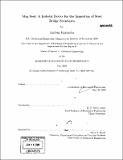Mag Feet : a robotic device for the inspection of steel bridge structures
Author(s)
Mazumdar, Anirban
DownloadFull printable version (38.82Mb)
Alternative title
Robotic device for the inspection of steel bridge structures
Other Contributors
Massachusetts Institute of Technology. Dept. of Mechanical Engineering.
Advisor
H. Harry Asada.
Terms of use
Metadata
Show full item recordAbstract
The aging of America's steel bridges presents many challenges. Undetected cracks and corrosion can eventually lead to catastrophic failure. Due to the difficulties with inspecting existing bridges the use of mobile robots for steel bridge inspection has become an important area of research. This thesis describes the analysis, design, and implementation of a new approach to steel bridge inspection robots using tilting feet equipped with permanent magnets. This robot, titled "Mag-Feet", is capable of adhering to steel surfaces and can move along steel surfaces using a combination of three distinct gait modes. These three gait modes allow the robot to "Moonwalk" along horizontal surfaces, "Shuffle" up inclined surfaces, and "Swing" over small obstacles. The "Swing" motions present their own set of interesting challenges. Since the robot can only adhere to the surface using finite (and relatively small) magnetic forces, it may fall due to the reaction forces caused by the swing- up motion. To prevent failure modes, an optimal swing-up trajectory was designed so that the maximum reaction force during the trajectory was minimized. The trajectories were parameterized using sigmoids and were determined by solving the dynamic equations as a 2 point boundary value problem. Finally, a proof of concept prototype was constructed and was used to experimentally evaluate the design. These experiments illustrate the promise of the design and control approaches that were formulated.
Description
Thesis (S.M.)--Massachusetts Institute of Technology, Dept. of Mechanical Engineering, 2009. Includes bibliographical references (p. 83-84).
Date issued
2009Department
Massachusetts Institute of Technology. Department of Mechanical EngineeringPublisher
Massachusetts Institute of Technology
Keywords
Mechanical Engineering.